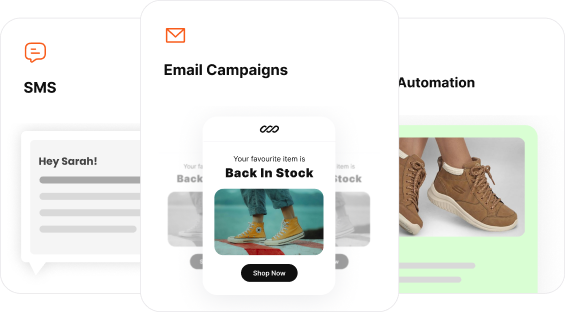Choose the right Shopify marketing apps for your goals
How many apps have you installed, only to add them to your “app graveyard” of wasted time and money? We understand the frustration, which is why we created this guide to focus only on what works.
Instead of an overwhelming list, we’ve organized the best Shopify marketing apps by their core function: boosting loyalty, driving conversions, recovering carts, and more. Inside, you’ll find our top picks for each category, with clear explanations of why they made the cut and how they can help you grow your business. Let’s get started!
There’s no single path to growth. Every brand has its own way of turning visitors into loyal customers.
Some focus on email or SMS marketing to bring shoppers back and recover lost carts. Others invest in loyalty programs to reward repeat buyers, or affiliate and referral programs to grow through genuine word-of-mouth. For stores with steady traffic, the goal often shifts toward boosting AOV and conversion through smarter upsells, bundles, and gifts.
To serve these different strategies, Shopify’s ecosystem is full of powerful apps built for each goal. We’ve tested, compared, and seen these apps in action across stores of all sizes. They’re reliable, well-supported, and proven to drive measurable results.
Up next, we’ll walk you through each category: what makes these tools special, where they shine, and how to pick the one that fits your store’s next stage of growth.
In-depth breakdown of top Shopify marketing tools
Email marketing apps
Email remains one of the most dependable channels for Shopify stores. It’s consistent, measurable, and builds long-term revenue without relying on ads. It helps brands speak directly to customers, recover lost sales, and create repeat buyers through meaningful, automated touchpoints.
It works best in two situations:
- Recovering abandoned carts — still around 70% of all checkouts on Shopify.
- Nurturing customers post-purchase — with flows that thank, educate, and bring them back.
When executed right, email turns into a steady growth engine rather than a one-off campaign. Two of the most effective apps for this are Retainful and Klaviyo, both trusted by Shopify marketers for their automation depth and proven ROI.
1. Retainful

Retainful is a lightweight, outcome-focused choice for teams that want fast setup, clean recovery flows, and a nudge toward the second order via its Next Order Coupon. It suits small teams that want to launch in hours rather than weeks.
Key features that matter for marketers:
- Abandoned cart and checkout recovery with ready-made workflows.
- Next Order Coupon to trigger a fast second purchase.
- Post-purchase thank-you or how-to sequences.
- Browse abandonment and win-back flows.
- Optional SMS and WhatsApp messaging in the same dashboard.
Before committing, note that Retainful works best for recovery-centric email programs. It’s easy to deploy and integrates well with Shopify, but it’s not designed for deep predictive segments or cross-brand analytics. We’ve seen that teams using it as their “quick-revenue” channel often get fast returns without complexity.
Pricing insight: Free plan includes 500 emails/month with basic automations. Starter plan at $14/month adds 20,000 email credits and more workflows. Growth plan at $69/month unlocks unlimited emails, full campaigns, and onboarding support.
Considering its automation depth, Retainful offers a high ROI for the price, especially for early-stage stores focusing on retention.
2. Klaviyo

Klaviyo is built for depth: large flow libraries, real-time segments, and broad integrations for brands that want lifecycle programs tied closely to merchandising and promotions. It often appears on best Shopify marketing apps lists when teams need precision and scale.
Klaviyo is built for depth: large flow libraries, real-time segments, and broad integrations for brands that want lifecycle programs tied closely to merchandising and promotions. It often appears on best Shopify marketing apps lists when teams need precision and scale.
Key features that matter for marketers:
- 60+ prebuilt flows for welcome, browse, cart, win-back, and more.
- Real-time, data-rich segments and predictive analytics for targeted email marketing.
- Cross-channel orchestration for email and SMS in one flow.
- Deep Shopify integration and 350+ partner apps.
- Benchmarks and reports to guide goals across the lifecycle.
For growing teams, Klaviyo’s learning curve pays off. We’ve found that its strength lies in building long-term programs with accurate data syncs and audience control. It’s ideal if your marketing team manages multiple customer segments or campaigns across email and SMS.
Pricing insight: Free to install, covering 250 contacts and 150 SMS credits. Paid tiers start at $15/month (SMS) or $20/month (Email), scaling with contact size. While pricier than Retainful, the platform justifies its cost for mid-to-large brands that rely on personalization and want a single source of truth for customer communication.
Conversion & AOV (Upsell, Bundles, Free Gifts) apps
Conversion and AOV tools help stores get more from the traffic they already have. Instead of chasing new visitors, they focus on increasing basket size and checkout rate — a smarter way to grow profit. Studies show that personalized recommendations can drive up to 31% of ecommerce revenue, while well-timed upsells and bundles can lift total sales by 10-15%.
They work best for:
- Boosting AOV with gifts, mix-and-match bundles, or tiered offers.
- Improving conversion rates by helping shoppers find and add the right items faster.
A strong example is BOGOS, an all-in-one app built for free gifts, bundles, and volume deals that reliably drive higher conversions on Shopify.
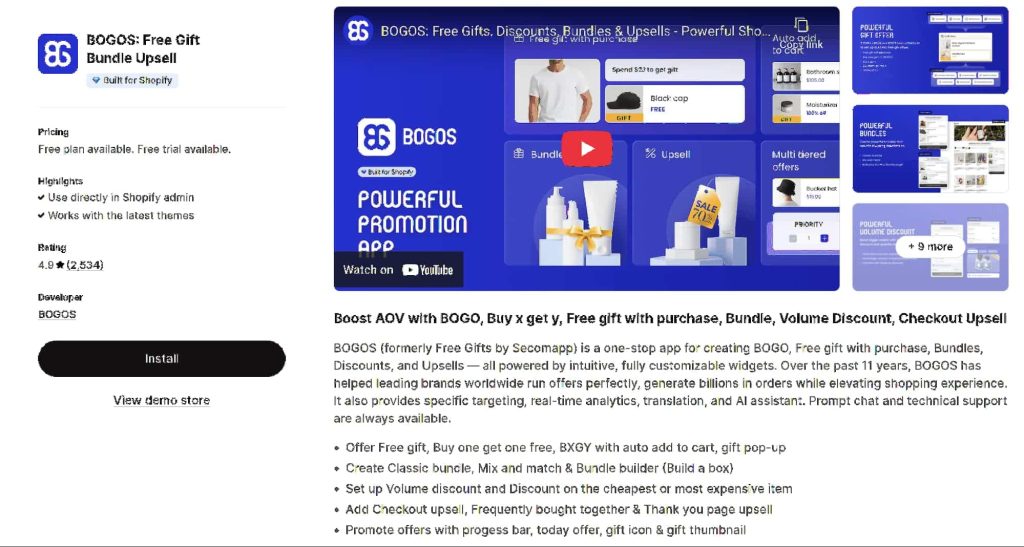
BOGOS brings the high-leverage promos marketers care about into a single, stable workflow:
- Free gift with purchase or selectable gift pop-up
- Buy X Get Y and tiered spend-to-gift thresholds
- Build-a-Box and mix-and-match bundles
- FBT and volume discounts
- Checkout and post-purchase upsell placements
BOGOS lets you run threshold-based gifts with a visible cart progress bar at the exact decision points (PDP, cart, checkout), a pattern supported by the goal-gradient effect in behavioral research and mirrored in practice.
Beyond gifts, BOGOS’s checkout and post-purchase placements capture additional revenue after checkout — a strategy proven effective in ReConvert’s 2023 report, where one-click post-purchase upsells converted at an average rate of 4.7% and drove a 5.6% uplift in AOV across millions of transactions.
Finally, BOGOS covers mix-and-match bundles and “frequently bought together,” which align with Shopify’s guidance that bundling increases AOV and helps shoppers complete purchases with fewer clicks.
If there’s one limitation, it’s price. BOGOS sits on the premium end, starting at $29.99/month and scaling with order volume, but that cost comes with enterprise-grade reliability and flexibility. For most stores, the ROI arrives within a few campaigns once gifts, bundles, and BXGY rules go live, and new users can still start with a free trial before scaling.
SMS marketing apps
SMS marketing is best when timing makes the difference between a missed opportunity and a sale. It reaches customers instantly, making it ideal for urgent updates, flash deals, and checkout recovery reminders. Compared to email, SMS often drives faster clicks and higher conversion rates because it cuts through the noise.
It works best for:
- Recovering abandoned carts and checkouts with short, actionable reminders.
- Time-sensitive campaigns like restocks, drops, and limited offers.
One standout tool that balances convenience with performance is Omnisend, a Shopify app that unifies email and SMS for seamless, automated engagement.

Omnisend works well when you want email and SMS under one roof. Its annual ecommerce reports show automated messages vastly outperforming manual campaigns, and the unified builder makes it easy to layer light SMS on top of proven email flows, which keeps it on many best Shopify marketing apps shortlists.
Key features that matter for marketers:
- Unified flows for browse, cart, and post-purchase triggers.
- Shared audiences and reporting across email and SMS.
- Planning tools for SMS character counts and country rates.
- Global sending with credit options on higher tiers.
- Free plan to test automations before you scale.
In our view, Omnisend’s biggest advantage is convenience. It’s perfect for brands that don’t need the granularity of Klaviyo but want cross-channel automation that “just works.” However, teams managing very large lists or custom data models might eventually outgrow it.
Pricing insight: Free plan for up to 250 contacts and 500 emails/month. Standard plan at $16/month supports 6,000 emails and basic SMS credits. Pro plan at $59/month unlocks unlimited emails, advanced reporting, and bonus SMS credits.
For the value it offers, Omnisend sits comfortably as one of the best marketing apps for Shopify in the all-in-one segment.
Related reading: How to send a link via SMS in 2025 (types, examples, benefits)
Loyalty & referrals apps
Loyalty and referral programs work because they turn happy customers into your best sales channel. Instead of constantly chasing new buyers, you grow profit through people who already trust your brand, and tell others about it. Even a small lift in retention (around 5%) can raise profits by up to 95%, showing just how powerful loyalty can be.
They work best for:
- Rewarding repeat buyers with points, tiers, and exclusive perks.
- Encouraging word-of-mouth through simple referral links and incentives.
Two great apps to make it happen are Smile.io and Yotpo Loyalty, both designed to make retention effortless and rewarding.
Smile.io

Smile.io gives you a branded loyalty hub that is easy to launch and easy to understand, so customers see how to earn and redeem at a glance. For a Shopify team, this clarity translates into more second and third orders without heavy custom work.
Key features that matter for marketers:
- Points on purchase and custom actions
- VIP tiers, point expiry, and bonus events
- Referral rewards with share links
- On-site nudges and embeddable widgets on the PDP and account
- Klaviyo sync for segments and lifecycle emails
Now, a few notes before you go live. We see the best lift when earn rules are simple and reward value is explicit everywhere a shopper makes a decision. Keep the number of tiers modest and surface “how to earn” on PDP, cart, and account pages so points feel real, not abstract.
Pricing insight: Free plan covers up to 200 monthly orders. Starter is $49/month up to 500 orders. Growth is $199/month, including 2,500 orders, then $20 per additional 100 orders. Plus is $999/month, including 7,500 orders, then $5 per additional 100 orders.
For most SMBs, Starter or Growth is the sweet spot; ladder up when analytics and integrations justify the step.
Yotpo Loyalty

Yotpo Loyalty connects retention with social proof in one ecosystem, which is powerful if you already run Yotpo Reviews. The same events that earn points can trigger review requests and UGC, so your loyalty spend also fuels content that converts.
Key features that matter for marketers:
- Points and tiers with flexible earn rules
- Referral flows and redeem at checkout, where available
- Program dashboards and cohort-level insights
- Integrations with Klaviyo, Recharge, and other Yotpo products
From our POV, Yotpo Loyalty performs best when the loyalty map is simple and measurable. Keep earning actions tied to behaviors that actually drive LTV (purchases, reviews, referrals), not low-value clicks. Be aware that checkout redemption requires Shopify Plus and the appropriate Yotpo plan; confirm eligibility early to avoid friction during launch.
Pricing insight: The Free plan is available for stores with under 100 monthly orders. Pro is $199/month, with $0.20 per order after 500 orders in a month. Premium is $799/month with advanced rules and reporting.
Model order volume and margins, since per-order fees can change unit economics in high-velocity periods.
Affiliate & referral marketing apps
Affiliate and referral marketing tap into the most reliable source of influence: real people. Instead of paid ads, your customers and creators become your advocates, sharing your products through trust and authenticity.
Research shows that 88% of consumers trust recommendations from friends and family more than any other channel, which makes referrals one of the most cost-effective acquisition strategies.
They work best for:
- Expanding reach through affiliates, influencers, and customer advocates.
- Driving low-risk sales with performance-based commissions that pay only for results.
A proven solution for Shopify stores is UpPromote.
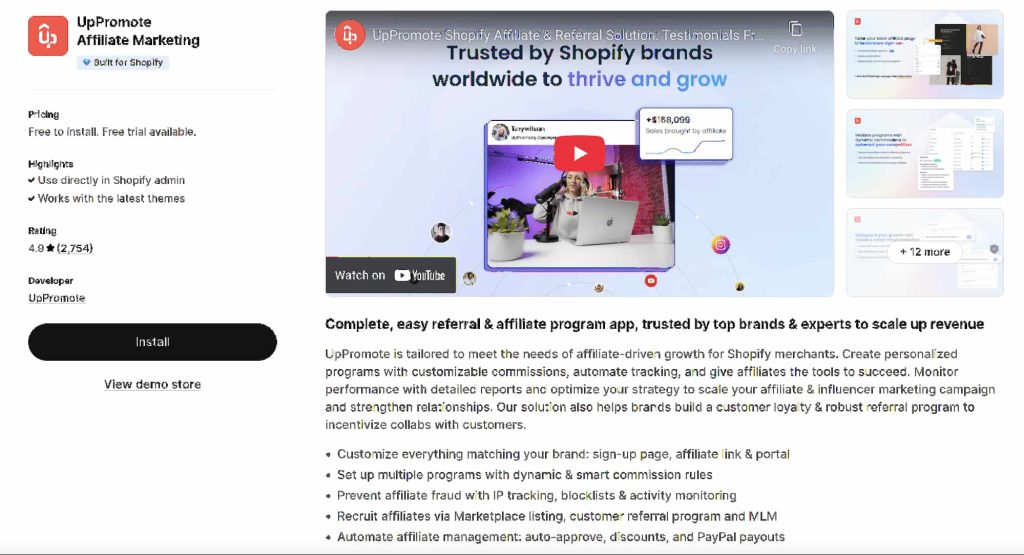
UpPromote gives Shopify teams everything in one place: recruiting and onboarding, link and coupon tracking, fraud checks, payouts, and even a marketplace for creator discovery. It is a practical choice when you want to run classic affiliates, influencers, and customer referrals from one dashboard.
Key features that matter for marketers:
- Tracking by affiliate links and coupon codes, with clear priority rules
- Commission rules by product, customer type, or campaign, plus lifetime/new-customer options
- Auto-generated coupons and branded registration pages
- Fraud protection, analytics, and automated emails
- Payout support via PayPal or manual methods, with 24/7 support
From experience, UpPromote is strongest when you segment programs by partner type and set simple, transparent commission tables. Start with links and unique coupons for clean attribution, then add bonuses for top performers. If you already run influencers, the marketplace, and code generation, speed up recruitment and tracking.
Pricing insight: Free plan available. Growth is $29.99/month plus 2% on successful referral sales, Professional $89.99/month plus 1.5%, and Enterprise $199.99/month plus 1%. The performance fee aligns spend to revenue, which many mid-market teams prefer.
Advertising apps
Advertising apps help you reach entirely new audiences, the fuel for long-term growth. They turn your product catalog into high-performing ad campaigns across search, shopping, and social channels, giving you visibility where shoppers are already looking and buying.
They work best for:
- Driving new customer acquisition through search, shopping, and social ads.
- Syncing catalogs and tracking conversions to optimize return on ad spend (ROAS).
For most Shopify brands, the go-to mix is Google & YouTube for intent-driven traffic and TikTok for creative, discovery-based reach.
Google & YouTube
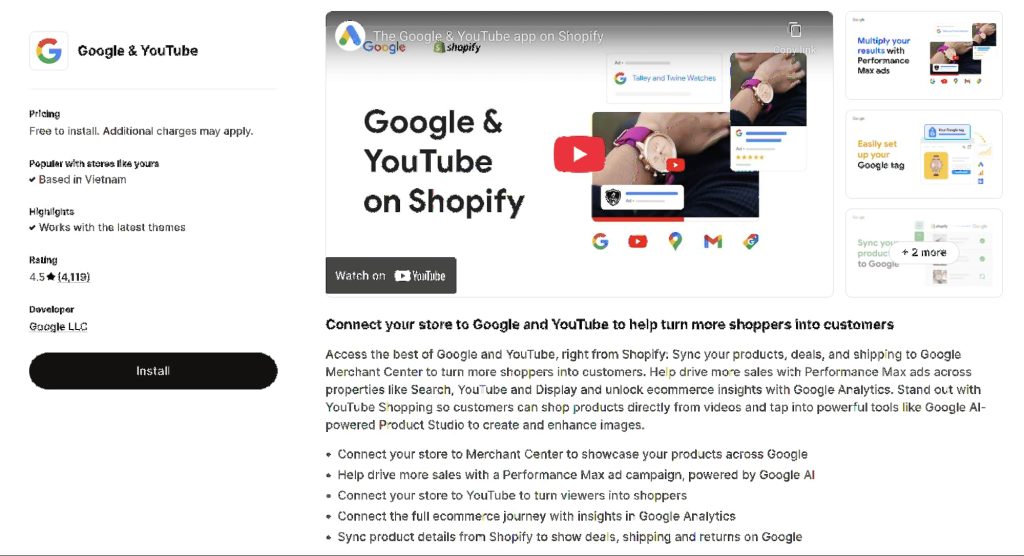
Shopify’s Google & YouTube app syncs your catalog to Google Merchant Center, powers Performance Max campaigns, and enables YouTube Shopping so products can appear directly under videos. Eligible US stores also get free product listings on the Shopping tab, and you can pipe results into GA4 for measurement.
Key features that matter for marketers:
- One-click product feed sync to Merchant Center
- Performance Max campaigns across Search, Shopping, YouTube, and Display
- YouTube Shopping to tag and surface products in videos
- Free listings on the Shopping tab for eligible US stores
- GA4 integration and feed updates from inside Shopify
A few notes are to keep your feed clean and product titles optimized to avoid disapprovals. Focus spending on high-margin SKUs and review Merchant Center errors weekly to maintain ROAS.
Pricing insight: The app is free. You pay your Google Ads spend, so start with conservative budgets and scale what meets your MER/ROAS targets.
TikTok
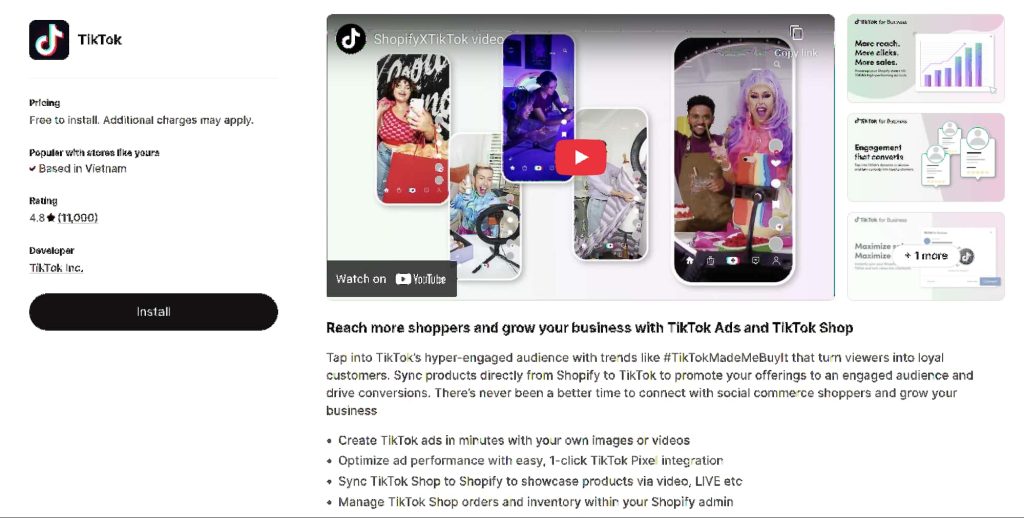
The TikTok sales channel integrates Ads, TikTok Pixel, and TikTok Shop with Shopify. You can sync products, track conversions without code changes, and manage TikTok Shop orders from the Shopify admin. This setup lets you test creative quickly and connect content to in-app shopping.
Key features that matter for marketers:
- Catalog sync to TikTok Shop and in-video shopping features
- One-click Pixel setup for event tracking and optimization
- Ad creation from the Shopify interface
- Order and inventory sync between TikTok Shop and Shopify
- Official setup guides and help center documentation for faster onboarding
Operationally, TikTok rewards rapid creative iteration. Ship multiple short variations, refresh weekly, and align product pages to the exact hooks used in the video. Keep attribution clean by confirming Pixel events, then scale winners while you fold the channel into the rest of your best Shopify marketing apps measurement.
Pricing insight: The channel app is free. You pay for ad spend and any TikTok Shop fees. Plan budgets per country, then ladder up based on CPA and new-customer ROAS.
Key considerations when choosing Shopify marketing apps
Before you install anything, focus on these 5 essentials that separate short-term fixes from tools that truly drive growth:
- Integration and compatibility: Make sure the app fits your Shopify setup (theme, checkout, and main tools like Klaviyo or GA4). A good fit saves hours of troubleshooting later.
- Performance and reliability: Lightweight apps load fast and don’t interfere with discounts or scripts. Always test site speed and checkout flow after installing.
- Data and privacy: Choose apps that follow GDPR and CCPA standards and provide clear consent tracking for email or SMS. Data control builds long-term trust.
- Pricing clarity: Know what drives cost (contacts, orders, or revenue share). Model for your busiest months to avoid sudden cost spikes.
- Support and time-to-value: Prioritize apps with fast setup, clear documentation, and quick support. The best Shopify marketing apps show measurable results within days.
Final thought
No single tool can do it all, which is why building a cohesive stack is so important for modern brands. We focused this guide on Shopify marketing apps that integrate cleanly and work together to support your core strategies. By matching the right app to the right goal, you can create a powerful, compounding growth engine.
Frequently Asked Questions:
Look at your primary growth goal; for example, recovering carts, boosting repeat purchases, or improving conversion. Then pick apps that specialize in that outcome, integrate with your current tools, and show measurable results for similar stores.
Many apps claim “one-click install,” and many do install quickly. But you should check that the app works with your theme, checkout, current plugins, and doesn’t slow down your store or create conflict.
Yes, you can, but you must test carefully. Make sure the apps don’t overlap rules (for example, two discount apps triggering at the same time), and monitor performance so one app’s code doesn’t slow your site or clash with another.
Most apps cost under $50/month for basic plans, though higher-tier apps can exceed $100/month depending on volume and features. The average across all apps is around $58/month per app.
Good apps offer real onboarding help, clean documentation, responsive chat or email support, and clear reporting so you can see early wins. They also give you templates and a sandbox or trial period to get started without major risk.


